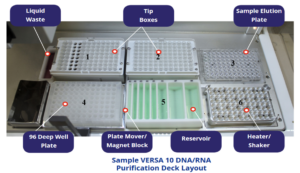In the revolutionary world of molecular biology, time and precision are of the essence. Laboratories around the globe are constantly seeking innovative solutions to streamline their workflows, and one breakthrough that has bring in attention is the automation of DNA extraction processes. In this blog, we delve into the integration of Aurora’s VERSA 10 liquid handling workstation with Thermo Fisher Scientific’s MagMAX DNA Multi-Sample Ultra 2.0 Kit (MMDNAT), showcasing a transformative approach to genomic research.

The Power of Automation
The MagMAX DNA Multi-Sample Ultra 2.0 Kit employs magnetic beads to isolate high-quality genomic DNA from diverse biological samples. This DNA serves as a fundamental building block for various molecular biology applications, including genotyping, sequencing, and PCR reactions. Automating this workflow involves meticulous protocol preparation on software, ensuring precise execution and validation within the laboratory setting.
Aurora’s VERSA 10, part of the VERSA series of automated liquid handling workstations, is at the forefront of this automation revolution. With a user-friendly software called VERSAware, the VERSA 10 is designed to cover low to medium throughput requirements, offering six deck positions and employing air displacement pipetting technology for accurate dispensing.
Unveiling the VERSA 10 Deck Layout
The VERSA 10 deck layout is a work of art, providing the capability to automate every step of magnetic bead-based nucleic acid purification. The six positions cater to tip boxes, a 96-well PCR plate, a 96-deep well plate, a reservoir, a magnetic block, and a shaker. The inclusion of a tip chute and liquid waste completes the layout, ensuring a sterile and no cross contamination for a seamless and efficient workflow.

The Automated MagMAX DNA Extraction Protocol
The automation protocol for the MagMAX kit involves meticulous steps to guarantee optimal results. From ensuring proper module selection to sample preparation, DNA extraction on tissue samples, washing, and elution, every step is automated, culminating in a ready-to-use qPCR plate for the next workflow.

Preparation Steps:
Selecting all modules properly on the software.
Ensuring DNA binding reagents/solutions are in the reservoir.
Placing consumables at their designated positions on the deck.
Filling tip boxes and attaching the tip chute to the bio-hazard bag.
Sample Preparation:
Transfer reagents into the reservoir and initiate heating of the Heater Shaker module.
Load Enhancer Solution, Proteinase K, and Extraction Buffer into the reservoir.
The robotic arm executes the liquid transfer based on the script.
Incubate the sample plate at 65℃ overnight.
DNA Extraction on Tissue Samples:
Manually transfer supernatant from tissue samples into the sample plate.
Load reagents into each well of the qPCR plate.
Automation kicks in with precise liquid transfers, shaking, and magnetic separation.
Washing:
The robotic arm dispenses wash solutions, shakes the plate, and uses the magnet to separate beads.
Liquid removal is automated for each washing step.
Elution:
The shaker heats up, elution buffer is added, and the plate is shaken and magnetically separated.
Automated transfer of eluted samples to the qPCR plate.
Conclusion:
The entire protocol is automated, and the final qPCR plate is ready for the next workflow.
User Experience: Saving Time and Improving Efficiency
According to the users at the University of Waterloo, the Aurora VERSA 10 has revolutionized their laboratory practices. From ELISA assay setup to genotyping, the VERSA 10’s ability to perform all steps of the genomic protocols has saved lab members a significant amount of time. This time-saving advantage allows researchers to focus on more critical tasks, such as data collection for their research.
Moreover, the switch to the VERSA 10 from manual pipetting has resulted in a noticeable decrease in error rates and cross-contamination, emphasizing the precision and reliability of automated workflows.
Acknowledgments
Special gratitude is extended to Associate Professor Jamie Joseph for his invaluable contributions to the internal validation process. His expertise and dedication have significantly enhanced the quality and accuracy of the instrument, contributing to the success of genomic research at the University of Waterloo.
In conclusion, the integration of Aurora’s VERSA 10 with Thermo Fisher Scientific’s MagMAX DNA Multi-Sample Ultra 2.0 Kit marks a significant stride in the automation of genomic workflows. Laboratories worldwide can now leverage this innovative solution to enhance efficiency, accuracy, and overall productivity in their molecular biology research endeavors. The future of genomics is automation, and the VERSA 10 is leading the way.



